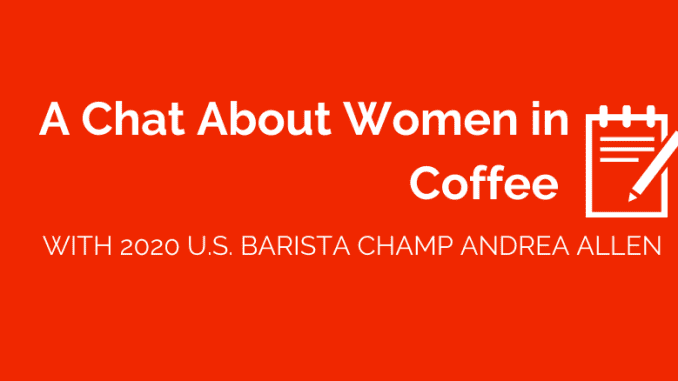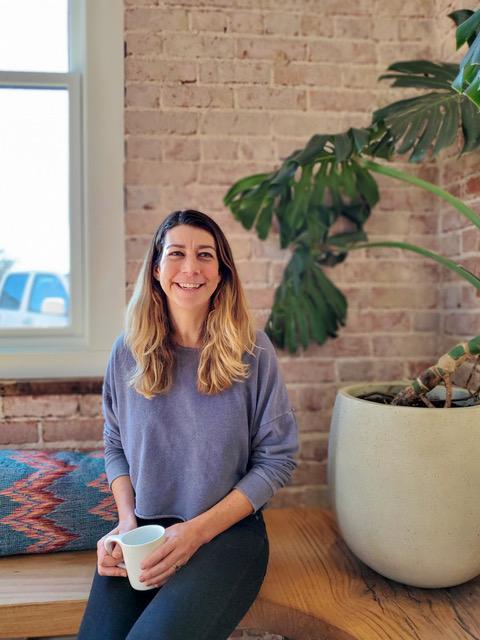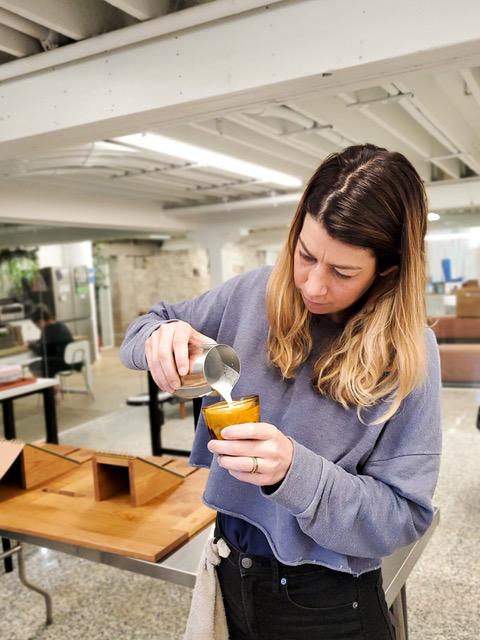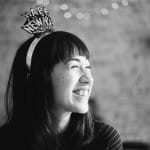
In advance of International Women’s Day this weekend, we ask Andrea about the increase of women in coffee competitions, as well as how her own winning routine came together.
BY KATRINA YENTCH
BARISTA MAGAZINE ONLINE
When veteran barista competitor Andrea Allen won the 2020 U.S. Barista Championship last month, she became the second female-identifying competitor within two years to take the title (after 2019 champ Sam Spillman). In 2016, Andrea spoke on women’s presence in coffee competitions, and a lot of advances have been made since that time—especially since she started competing in 2014. In 2019, women had a very strong showing in the finals of all categories of the U.S. CoffeeChamps, and Andrea is now constantly interacting with female and non-cis, white-male-identifying roasters, green buyers, Q-Graders, and other roles beyond the bar. To celebrate International Women’s Day on March 8, we talked with Andrea further about women’s advancement in the coffee industry, as well as how her own winning routine came together.

Katrina Yentch: 2019 was the first year that really demonstrated a female-heavy presence in coffee competitions, and your recent win makes it two years in a row of fem-identifying champions. What does that mean to you?
Andrea Allen: Well it means a lot! When I first started competing [in 2014], they were mostly male. I remember being asked about it at the time back in that 2016 article and we may have discussed it a little bit, and I just remember thinking it was interesting that competitions didn’t reflect what I saw at my own cafés, or just cafés in general, like the makeup of people. And I think that goes for females as well as other kinds of people that identify different ways, and other races and cultures et cetera. So for me seeing more women, and also just seeing the competitions begin to look and sound and feel different, has meant a ton. I think it’s just showing the people that are already working in the industry, and doing a great job regardless of who they are, that competition is open to them and that their voice is valued. I think it’s been refreshing to see that reflected at competition as a whole. I’m grateful to have been, before this opportunity, to be there and to be able to come that way for it.
“Layers” were a consistent theme throughout your routine. What are some other ways you brainstormed the incorporation of layers into your beverages?
I started talking to [my husband] Jon about the concept of this thing called a palimpsest. It’s essentially an ancient manuscript where whenever it’s time to write something different on it or something new, they actually just physically scrape the words off, and it’s usually like an animal hide of some kind, but every time they scrape, they can’t get everything off. So they put new on top of old stuff, and it’s a concept I’ve loved and thought about over the years. It feels like it really strongly connects to hospitality in terms of being where our expectations, our desires, the things that we like in cafés or in restaurants and coffees, are all things that are constantly being built on each other.
As we have experiences, they inform us about what we like or what we don’t like or what we want to see more of or what we want to stay away from. So just like, having that concept particularly in a café, where you might have several dozen tiny interactions with a customer that build up to that customer feeling connected to your coffee or connected to your café, as opposed to having this one amazing experience in a café. That concept of layering all the experiences, and then inside of that having coffee, just made me really think about how we can think of how hospitality works and the barista’s role in that, and that is just enough.
In terms of the drinks, we started the season by building the espresso and milk drink and I served it first, when I normally serve espresso [first]. The idea is, once you have something on your palate, whatever comes next kind of has that influence. So I’ve always done espresso first because I don’t want milk on the judges’ palate. But this year it’s actually really interesting to taste the espresso after you’ve already had milk, and actually layering the flavor and the body and all the characteristics of the espresso after milk was really interesting.
And then even inside of the espresso I was trying to use two coffees and I was, like, blending them, and the Eugenioides was this tiny ultra dense coffee bean and the Cerro Azul is this Gesha … all Gesha beans are typically long, large, just a totally different density. Every single shot I was making was wildly different, and it was just like, “OK, we need to totally separate these coffees and make two layers.” Inside of that it just happened to work. So we always start with the presentation and the concepts of that first. And then we work the drinks into the theme, or sometimes it just happens to work out.

What are some ways that your company tries to incorporate women in aspects of coffee besides behind the bar?
Seventy-five percent of our management team [at Onyx Coffee Lab] is women. We predominantly, more than 50% across the board, are female in general. I think for us, I see females in our company being very detail-oriented and having really great focus, really wanting to make great coffees, make great places for our staff to be in terms of our shop community, really wanting to offer awesome hospitality to our customers. We really try to promote that and reward that inside of our team. At least for us we have quite a few females on our leadership team, and that’s something I feel proud about.
A lot of competitors have also been making an effort to feature coffees produced by women or roasted by women. Has this affected how your company has been buying coffee lately?
Two of our roasting team are females, which is awesome. And then I do get particularly inspired by certain female producers. There’s one in Nariño named Raquel Lasso. In the last couple of years she had some coffee that was really, really good, and she’s kind of the leader of the association of growers in her region. She’s also the official leader in that area and has tons of really cool initiatives like … there was this one where she basically gave cows to women that were in not great financial and relational situations, and showed them how to take a cow and milk it and make cheese and sell it, and to help them gain financial independence, which is super cool. Things like that I feel are super inspiring to me, seeing women across the world working hard at great products and making a difference in coffee. That’s something that I get inspired by, and that we try to embrace as much as we can here.

